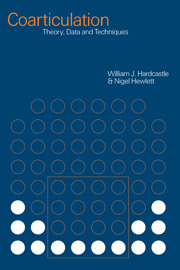Book contents
- Frontmatter
- Contents
- List of figures
- List of tables
- List of contributors
- Acknowledgments
- Introduction
- Part I Theories and models
- Part II Research results: components of the motor system for speech
- Part III Wider perspectives
- Part IV Instrumental techniques
- 10 Palatography
- 11 Imaging techniques
- 12 Electromagnetic articulography
- 13 Electromyography
- 14 Transducers for investigating velopharyngeal function
- 15 Techniques for investigating laryngeal articulation
- 16 Acoustic analysis
- References
- Index
10 - Palatography
Published online by Cambridge University Press: 22 September 2009
- Frontmatter
- Contents
- List of figures
- List of tables
- List of contributors
- Acknowledgments
- Introduction
- Part I Theories and models
- Part II Research results: components of the motor system for speech
- Part III Wider perspectives
- Part IV Instrumental techniques
- 10 Palatography
- 11 Imaging techniques
- 12 Electromagnetic articulography
- 13 Electromyography
- 14 Transducers for investigating velopharyngeal function
- 15 Techniques for investigating laryngeal articulation
- 16 Acoustic analysis
- References
- Index
Summary
Introduction
Electropalatography (EPG) has become a widely used laboratory technique for recording and analysing one aspect of tongue activity, namely its contact with the hard palate during continuous speech. EPG in its present form developed from less sophisticated techniques of palatography which were able to record only the location of tongue–palate contact (for a review of earlier forms of palatography, see Hardcastle 1981). In one type of palatography, the surface of the palate is covered with a dark powder, usually a mixture of charcoal and chocolate. The speaker then produces a sound or sound sequence and the resulting area of ‘wipe-off’ on the palate is photographed (Abercrombie 1957). Records such as these provide useful spatial information about the location of tongue–palate contact, but the crucial dynamic dimension cannot be captured using this form of palatography. EPG, or dynamic palatography as it is sometimes called, has been developed in order to do just this, and current models provide information relating to both temporal and spatial aspects of tongue–palate contact.
EPG as a technique in phonetic research has numerous attractions, which lie in a combination of practical features, such as conceptual simplicity, ease of operation and relative non-invasiveness. In the discussion which follows the first section describes the main features of current commercially available EPG systems. This is followed by an account of ways in which EPG raw data can be processed in order to extract useful measures for the investigation of lingual coarticulation.
- Type
- Chapter
- Information
- CoarticulationTheory, Data and Techniques, pp. 229 - 245Publisher: Cambridge University PressPrint publication year: 1999
- 25
- Cited by



